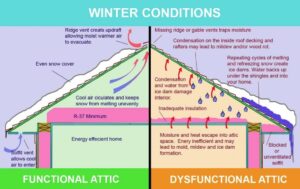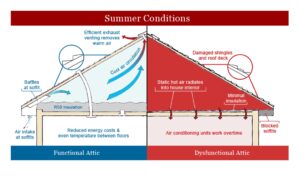When we think of our roof, we think shingles – what we can see. But there is always more going on beneath the surface, and roofing is no exception. One thing that will protect the life of your roof, keep your home the right temperature for the season, and help keep your family healthy, is adequate ventilation and insulation.
Roof Ventilation in Layman’s Terms
Your roof vent system is a combination of intake and exhaust vents that allow for proper airflow and temperature maintenance, regardless of the season. Why is this important? Moisture. Moisture is the cause of many home problems. Wait, what does moisture have to do with air flow? Think of your bathroom when you shower and do not have a bath fan. The door is closed, steam rises, and condensation appears on your bathroom ceiling and walls. Now picture this same thing in your attic, only on a larger scale. All day you are cooking, cleaning, showering, and doing laundry. Hot air rises and moisture builds up if there is nowhere for it to go or nothing to cool it down. The exhaust vents near the top of your roof allow the hot air to escape. Intake vents, often found near the bottom of your roof or in the overhangs, draw in cool air to balance the hot air. When your intake and exhaust vents work together properly, there is continuous air flow that maintains a consistent temperature. It can be pretty tricky to figure out the best balance and placement of vents to create the correct flow (some areas of your attic may need different types of vents). Roofing is hard to DIY, so call a professional if you have questions.


Is There a Problem?
One way to identify a problem is to watch for signs of excess moisture. Check your attic for mold, black discoloration, warped or rotting wood, or rusty nails. Make sure your bath fan vents out of its own exhaust vent and not into the attic. Updating your ventilation is less expensive than a full roof replacement or the other problems unwanted moisture can cause.
Insulation works with proper ventilation to maintain a consistent temperature in your home. If you had ice buildup or a lot of icicles on your roof this winter, that means either too much heat is escaping or is escaping more in certain areas. Do you go upstairs and it’s quite a bit warmer than the main level? If your home does not heat or cool efficiently, ventilation or inadequate insulation could be part of the issue. As always, it is best to call a Grand Rapids Roofing professional to help you assess what your home needs.
